OpenAI’s GPT-4 language model is considered by most to be the most advanced language model used to power modern artificial intelligences (AI). It’s used in the ChatGPT chatbot to great effect, and other AIs in similar ways. But that’s not the end of its development. As with GPT-3.5, a GPT-4.5 language model may well launch before we see a true next-generation GPT-5.
Here’s everything we know about GPT-4.5 so far.

What is GPT-4.5?
GPT-4.5 is the theorized stop-gap next advance in OpenAI’s language models, following on from the highly successful
The GPT-3.5 model is widely used in the free version of ChatGPT and a few other online tools, and was capable of much faster response speed and better comprehension than GPT-3, but still falls far short of GPT-4.
What can GPT-4.5 do?
At the time of writing, GPT-4.5 hasn’t been officially announced, so we don’t know for sure what it will be able to do. However, we can speculate based on past OpenAI development.
GPT-4.5 would likely be built using more data points than
At the time of writing, GPT-4 is restricted to data preceding the fall of 2021. Any future
The launch of GPT-4 also added the ability for ChatGPT to recognize images and to respond much more naturally, and with more nuance, to prompts.
It’s possible that GPT-4.5 would also be able to remember more information, utilizing past conversations to build upon for its future responses.
When will GPT 4.5 be available?
There’s no timeline for GPT-4.5’s release. Initial estimations and rumors based on the early 2023 launch of
For now, we have no idea when GPT-4.5 will be available to use, although some have suggested that if OpenAI were to take its plugins, web search, code interpreter, and custom instructions out of beta, that could constitute an upgrade to
What about GPT-5?
Although there was a lot of hype about the potential for GPT-5 when GPT-4 was first released, OpenAI has shot down all talk of GPT-5 and has made it clear that it isn’t actively training any future GPT-5 language model. It claims that much more in-depth safety and security audits need to be completed before any future language models can be developed. CEO Sam Altman has repeatedly said that he expects future GPT models to be incredibly disruptive to the way we live and work, so OpenAI wants to take more time and care with future releases.
However, OpenAI has in more recent times filed a trademark for the name GPT-5, and has launched a web-crawling bot that will harvest information from the internet for training future language models — presumably GPT-5. This could prove problematic though, since OpenAI is being sued by several organizations and individuals for the unlawful use of their work in training GPT language models.
At the very least, GPT-5 appears to be a long way off from release. GPT-4.5 may not have been announced, but it’s much more likely to make an appearance in the near term.
Editors' Recommendations
- AMD Zen 5: Everything we know about AMD’s next-gen CPUs
- GPT-4 vs. GPT-3.5: how much difference is there?
- New report says GPT-5 is coming this summer and is ‘materially better’
- GPTZero: how to use the ChatGPT detection tool
- Is ChatGPT safe? Here are the risks to consider before using it




